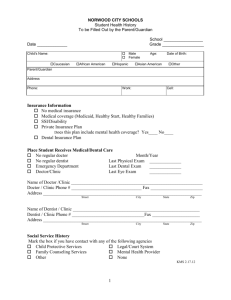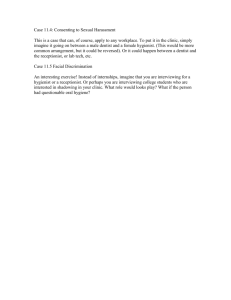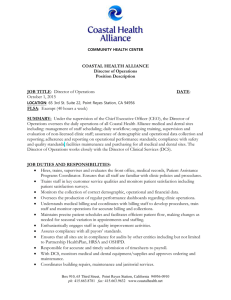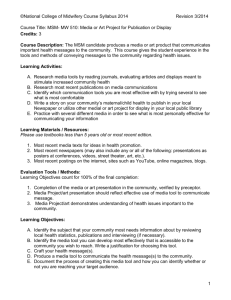Subsequent Affiliation Narrative Template
advertisement
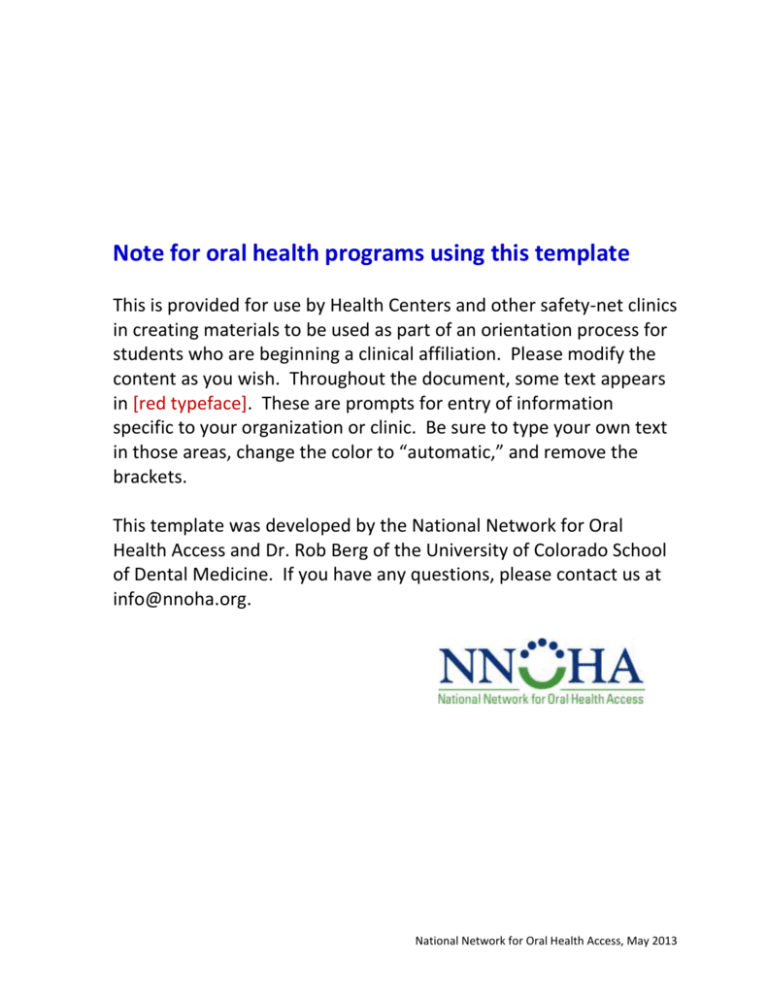
Note for oral health programs using this template This is provided for use by Health Centers and other safety-net clinics in creating materials to be used as part of an orientation process for students who are beginning a clinical affiliation. Please modify the content as you wish. Throughout the document, some text appears in [red typeface]. These are prompts for entry of information specific to your organization or clinic. Be sure to type your own text in those areas, change the color to “automatic,” and remove the brackets. This template was developed by the National Network for Oral Health Access and Dr. Rob Berg of the University of Colorado School of Dental Medicine. If you have any questions, please contact us at info@nnoha.org. National Network for Oral Health Access, May 2013 Orientation to your affiliation with XYZ Health Center’s clinic in [ ________ ] [XYZ] Health Center Our health system was founded in [year]. Our mission is to [type organization’s mission statement here]. We’re governed by a board made up of [number] people from the community who support our mission and put their own talents to work in helping us achieve it. [XYZ] now operates [number of clinics] and/or [locations of clinics] where we work to enhance the health of our community. Our team of providers includes physicians, dentists, and [list others]. Our medical team has about [number] active patients and provided [number] clinic visits in [year]. We also provided [other, e.g. mental health] services to [number] people. About [number] people visited our dental clinic[s], where we provided [number] patient visits. Our [e.g. pharmacy] served [number] patients at [location]. As you might expect, we provide community-oriented primary health care to people of all ages and backgrounds. You might not know about some of our programs aimed at specific populations – people who face health risks or have needs that call for targeted interventions. Some of these include [list and describe initiatives here]. While on this clinical affiliation, you’ll be part of our mission. We’re glad you’re here. We hope that your work with us furthers your education and resonates with your value system. Section 1: Get to know us Working at our clinic Here are the times you’ll be at work in our clinic – The dental clinic is open from [time] to [time], [day] through [day]. Please arrive by [time] each morning. That will give you time to prepare for your first patient and talk briefly about the morning schedule with the other staff members. We usually begin our midday lunch break at [time]. Please return to the clinic by [time] to prepare for the afternoon session. The last scheduled patient appointment each day is at [time]. The target time at which our support staff members hope to leave for the day is [time]. As the morning and afternoon sessions draw to a close, our clinic remains open until patient treatment is concluded. However, it’s important that you consider your staff member’s schedule and set a realistic pace for the care you provide. It will be our goal to help you enhance your ability to manage time effectively and meet the demands of a busy schedule. Once the support staff leaves, you may talk with your supervising dentist and seek permission to leave as well. National Network for Oral Health Access, May 2013 Make yourself comfortable – The clinic provides staff parking in [describe area and any parking rules that will apply to the student]. You can enter the building through [describe the best entrance for staff to use]. When you arrive, your coat, backpack and other belongings are best placed in [describe a secure place for these items]. We invite you to take quick breaks during the day in [someone’s] office and you can eat your lunch in [location]. Staff restrooms are [location]. Delays and absences are a major problem for us – Sometimes road conditions and traffic problems can be predicted, but often that’s not possible. We know that some delays are unavoidable. Even so, when you start your first patient’s appointment late, you may be affecting your coworkers’ schedule for the entire day. Add this phone number [contact person and number for late arrival] to your phone’s speed-dial list. If you think you may be delayed, call and let us know. Of course absences have an even greater impact on our schedule than late arrivals. As soon as you realize that you are too ill to practice or you become aware that someone who depends on you is ill, we need to know. For absence due to illness, call [contact person and number for absence]. Please add this to your speed-dial list too. Meet our faculty and staff Primary clinical supervisor – Your primary clinical supervisor, primary preceptor, during this affiliation will be Dr. [Name]. [She/he] earned [her/his] dental degree at [university] [and completed a _____ residency at ________]. Subsequently, Dr. [Name] practiced dentistry for about [years] at [practice location] and for about [years] here. [She/he] lives in [community or location] and [list something interesting about her/him]. Your school considers Dr. [Name] their primary contact at our clinic and for your education while you’re here. Your weekly and end-of-affiliation assessments will be done with [her/him]. We hope you’ll make an effort to get acquainted and form a close working relationship with one another. Other staff dentists – You may also be supervised in our clinic by the other staff dentists listed here. Your school has authorized them to be preceptors for you and we hope you’ll develop a rapport with them as well. Dr. [Name]: [She/he] earned [her/his] dental degree at [university] [and completed a _____ residency at ________]. Subsequently, Dr. [Name] practiced dentistry for about [years] at [practice location] and for about [years] here. [She/he] lives in [community or location] and [list something interesting about her/him]. Dr. [Name]: [She/he] earned [her/his] dental degree at [university] [and completed a _____ residency at ________]. Subsequently, Dr. [Name] practiced dentistry for about [years] at [practice location] and for about [years] here. [She/he] lives in [community or location] and [list something interesting about her/him]. National Network for Oral Health Access, May 2013 Dr. [Name]: [She/he] earned [her/his] dental degree at [university] [and completed a _____ residency at ________]. Subsequently, Dr. [Name] practiced dentistry for about [years] at [practice location] and for about [years] here. [She/he] lives in [community or location] and [list something interesting about her/him]. Other clinic team members – Our clinic depends on a dedicated group of people who support the dental providers and operate the clinic in which we provide treatment. Our dental hygienists are [Name] and [Name]. Our clinic operations manager is [Name]. She/he [briefly describe this person’s role]. Other key team members are [list names here]. They already know your name, so be sure to learn their names. Who we treat Our geographic focus – We have defined our mission as serving people in [describe the geographic area that you serve]. [For FQHCs: You may hear the term “catchment area” used to describe this area. The federal program that provides some of the primary funding for FQHCs, also known as Community Health Centers, uses that term.] Within this area, we monitor the challenges and barriers that affect health status and access to health care and seek ways to help the community overcome them. We take a special interest in the schools located in the area, including [list any schools in which your organization takes special interest]. Pediatric patients – People aged [age] and younger make up approximately [number] percent of our active patients and [number] percent of our patient visits. Serving them is vital to our mission. Pediatric practice can be challenging to an inexperienced dentist, particularly since the majority of patients seen in dental school clinics are adults. On the other hand, treating children is one of the most rewarding things a dentist can do. Please be completely honest with your preceptors about your experience with treatment of children. In addition to the unique procedures associated with pediatrics, managing a child’s anxiety and behavior is an art that you will learn over time. With your preceptor’s help, you can build confidence with the procedures and management techniques you’ll need to effectively treat children here and in your future practice. Services available for specific medical conditions and age groups – We’ve monitored the needs of our community over the years. As a result, we’ve identified population sub-groups who are at elevated risk for poor oral health and require our particular focus. Here are some risk groups and the efforts we have in place to address those risks: [Risk group, e.g. pregnant women]: [Describe effort or program] [Risk group, e.g. older adults]: [Describe effort or program] In addition, our dental department works closely with our medical providers to provide consultation and intervention when they identify individuals at risk. National Network for Oral Health Access, May 2013 Levels of care – Because there is so much oral health care need within the community, an important task for community health providers is triage. We need to allocate the available resources responsibly. This means always addressing acute infection and pain, but also making a broader range of services available in an equitable manner. Here’s the current allocation matrix: Urgent care makes up about [number] percent of adult visits. Urgent care is defined as treatment of acute infection and/or pain. Limited care makes up about [number] percent of adult visits. Limited care is defined as [your organization’s definition, e.g. Phase 1 care only]. Comprehensive care makes up about [number] percent of adult visits. Comprehensive care is defined as [your organization’s definition, e.g. Phase 1 and Phase 2]. We are not able to provide [specific services, e.g. second molar endo] at this time. Section 2: Practicing in our clinic Review of practice rules Scheduling and allocation of patients – At our clinic we [do/don’t] have a student column in our schedule. [Describe how patients are scheduled, how the student will be able to see the plan for her/his day of patient care, and to whom the student should speak about bringing the next patient to a treatment area.] Review chart and brief preceptor before entering operatory – Before you enter a treatment area and greet a patient, you must review the patient’s chart and the planned treatment. Computers with access to the EDR are available outside the treatment area. We want you to make yourself familiar with relevant histories, proposed treatment, and recent progress notes. Then, brief your supervising dentist (your preceptor) on the key patient data and any concerns you may have. Introduce yourself to the patient as a student dentist – Our clinic’s general consent for treatment includes the possibility of treatment being provided by a student dentist practicing under a licensed staff dentist’s direct supervision. According to many legal experts, this is sufficient written consent for the situation. However, the patient must also be aware of (informed) which provider is the licensed dentist and which is the student dentist. This is done by your wearing the appropriate student dentist identification badge (provided either by your school or by our clinic) and by your verbal introduction of yourself. Then the next step is verifying the patient’s identity by asking, “Are you _______?” Prescribing policies – Please review this summary of our prescribing policies, both for nonnarcotic and narcotic medications. [Type that summary here.] National Network for Oral Health Access, May 2013 Remember, you’re practicing under your preceptor’s license – After practicing for a while, it’s sometimes easy to forget that you have not graduated from dental school and do not have a license to practice dentistry. It is important that you feel a sense of personal responsibility for the care you provide, but you always remember that your preceptor is legally responsible for everything you do for your patients. Please review the following “no exceptions” rules for practice: Never change any portion of a treatment plan or any feature of a planned treatment without your preceptor’s knowledge and permission. For example, do not change from alloy to composite without discussing the change with your preceptor and receiving permission. If you’re ahead of schedule during a patient’s appointment, it can be tempting to move ahead with a planned treatment procedure. That treatment would cause a charge the patient did not anticipate. Before talking with the patient about additional treatment, discuss it with your preceptor, to avoid putting your patient in an uncomfortable position. Always comply with rules established by your preceptor. In addition to any personal rules that your preceptor might have, at our clinic we have a rule of threes: You must have permission from your preceptor before (a) injecting a third carpule of local anesthetic or (b) retaking the same radiographic view for a third time. Never star treatment or dismiss a patient without your preceptor’s knowledge and approval. Charts and notes Learn to use our EDR system – There are many different electronic dental record (EDR) systems available to dental offices. We use [name of your system]. Please speak with [Name] and use our training materials to make yourself familiar with how to navigate our system. At minimum, practice locating and reviewing medical histories, dental histories, and treatment plans. When you have an assistant, you will not need to fill in the patient data that you collect. However, it is never permissible to have your assistant write your progress note. That is always the responsibility of the provider who treated the patient. Progress notes must be reviewed and countersigned – Your progress notes must be reviewed and counter-signed by the preceptor who supervised the patient’s treatment. While reviewing your note, the supervising dentist may want to discuss it with you and some change to the note may be needed before it is signed. To make sure there’s enough time for this, we require that progress notes be completed, reviewed and counter-signed before the end of the session (morning or afternoon) in which the patient was seen, usually by [times, e.g. 11:45 and 4:45] daily. Here are our rules for progress notes – Don’t use unnecessary abbreviations and don’t leave misspelled words in the note. Make sure you include a history update, diagnostic codes, type and dosage of local anesthetic, CDT codes, and pain levels in the note. Also, National Network for Oral Health Access, May 2013 please check tooth numbers, other data and spelling carefully before bringing the note to your preceptor. Please review these specific structural elements of our progress notes at [XYZ]: [Describe your progress note structure here.] Surgical safety checklist Our clinic’s surgical safety checklist is intended to reduce the risk of errors that would harm our patients. This checklist is based on current accepted practice and it represents another set of “no exceptions” rules for practice. Sign-in, prior to administering anesthetic – Assess your patient’s vital signs and confirm your patient’s identity. Review the planned procedure(s) and site(s) with your supervising dentist. Review the planned procedure(s) and site(s) with the patient. As part of this discussion, ensure that written informed consent has been reviewed, signed and witnessed. Confirm whether or not any medical prophylaxis is needed and, if so, that it has been done. Time-out, prior to cutting tissue – Verbally confirm procedure(s) and site(s) with team and patient. Review available radiographs and treatment plan. Confirm availability of needed instruments. Sign-out, prior to dismissing patient – Assess patient’s vital signs Provide post-operative instructions Review case with supervising dentist and obtain permission to dismiss Sharps injury response Rule #1 is to be careful and prevent sharps injuries – It should be obvious, but knowing how to avoid sharps injuries is even better than knowing what to do about them. You will be practicing in an unfamiliar clinic, with carts and instruments sometimes in locations you don’t expect. In our clinic, it’s likely you will also be practicing at a faster pace than you are used to. Both of these features of your practice with us may place you at higher risk of a sharps injury. The way to increase your “clinical speed” is to make your movements more efficient, but not necessarily faster. Here are some suggestions for becoming more efficient: Know what you’re doing – before sitting down to begin treatment, review the needed steps in your mind. National Network for Oral Health Access, May 2013 Prepare your operatory – look at the instrument table before you begin, to verify that the instruments and supplies you plan to use are there. Avoid needless backtracking – don’t repeatedly alternate between two instruments. Use an instrument until you’ve accomplished what you intended when you picked it up; then return it to your assistant and begin the next step in the procedure. Accidents happen, but there are many common sense ways to make them far less likely to occur. Here is a summary of the rules we’ve put in place to reduce your risk of sharps injuries while you’re practicing with us: [Describe your rules for handling burs and other sharps] [Describe your rules for safe injection technique] What to do if you have a sharps injury – If you think you have had a sharps injury, you must stop patient care immediately and discuss it with your preceptor. If you and your preceptor consider your injury an exposure to bodily fluids, the first step in the response is for the injured worker (you) to stop patient care. The procedure should be completed or temporized by another dentist, usually your preceptor. When you’re not sure whether the injury qualifies for the sharps injury response, you can call experts at UC-San Francisco at the PEPLine, 1-888-448-4911. Discuss it with them and then decide what to do. The worst thing you can do is decide it was not a serious injury in the afternoon, then change your mind later that evening. Two blood draws are needed – A blood sample must be drawn from the injured worker (you), in order to establish that you are not currently seropositive for HBC, HCV or HIV. Blood must also be drawn from the source patient, to determine if he/she is seropositive for any of these viruses. Samples must be tested as soon as possible – If “rapid testing” is available, the blood samples will need to be draw in “gold-top” vials known as SSTs, or serum separator tubes. These tubes must be kept chilled and delivered to the lab for rapid testing within two hours of being drawn. If the patient is seropositive for HIV, pharmaceutical prophylaxis regimens are available, but they must be implemented as soon as possible after the injury. As part of the response to an exposure, the worker (you) must be seen by a physician trained for the event. Typically, if rapid testing of the source patient’s blood is not possible, it is recommended that the injured worker undergo the pharmaceutical prophylaxis until the source patient is confirmed to be seronegative for HIV. Review of HIPAA rules You must read our HIPAA training materials – Please talk with [Name] about our Personal Health Information (PHI) rules and review our training materials. We know you have National Network for Oral Health Access, May 2013 already had HIPAA training at your dental school and at other clinical affiliations, but you need to review our clinic’s rules. PHI privacy – The privacy rule applies to printed, spoken and electronic forms of information. It says that PHI can only be accessed with the patient’s permission and only for the purpose of doing your job related to treating the patient. PHI security – The security rule is aimed at making sure providers retain secure custody of PHI, so that it doesn’t get out into the world. That means being careful with paper documents, protecting electronic documents and only speaking about PHI in places where you will not be overheard by unauthorized people. Sometimes PHI needs to be faxed, emailed, given over the phone or left on voicemail. Make sure you’re using the correct fax number, email address, or telephone number. On the phone, confirm who you are speaking to. When you send PHI by email, it must be encrypted email. When sent within your university’s network, email is typically secure. Outside that network (for example Gmail or Yahoo), it is usually not secure enough for PHI. Talk with your preceptor before emailing any PHI. Social networking sites are not secure enough for PHI. Never put PHI on a site like Facebook, even if a patient asks you to do so. When a computer is logged into a clinic’s server or EDR, you should assume it has access to PHI. Never leave a computer with access to PHI unattended. Before walking away from it, log out or activate a passwordprotected screen saver. Computers that can log into a clinic’s server or EDR may never be used to access peer-to-peer websites. These sites are sometimes used to share data, music or video files. Visiting such a site would place the computer at risk of being compromised by spyware that could access our server or EDR. Ask for permission before visiting any website with our clinic computers and please don’t surf around the web with our computers. PHI is sometimes written on sticky notes or loose pieces of paper. If these are intended as part of the patient’s record, they must be scanned into the EDR. Whether scanned or not, do not leave paper with written PHI lying on a counter or desk. It must be shredded as soon as it’s no longer being actively used. No PHI is allowed to be saved to flash drives or other removable storage devices. This also applies to your personal laptop computer, tablet or smartphone. When you have a conversation in which you mention PHI, make sure you are in a non-public area. Never discuss PHI in the reception area or in a hallway outside our treatment areas. National Network for Oral Health Access, May 2013 What we expect of you Write down the goals you want to achieve in this affiliation – Our purpose in hosting you at our clinic is to help you further your education. Your preceptor can’t effectively do that without your active participation. So please write down some goals you have for your time with us and discuss them with Dr. [Name] today. [She/he] will help you refine them and ensure that you begin the affiliation with a set of achievable goals. Then make sure you meet with Dr. [Name] at least once each week, to discuss progress toward meeting your goals. Please don’t leave those meetings to chance or assume they can occur at the end of the day on Friday. Instead, set up a date and time to meet each week and then seek out Dr. [Name] for those sessions. It doesn’t need to be the same date and time each week, but it needs to be a specific item on your calendar and [her/his] every week. Remain engaged with us in a learning experience – Please be an active participant in your affiliation. For us, you are not one of many students in a class. The rest of the people in that class are somewhere else and you are our student dentist, here and now. We invite you to take responsibility as a staff provider on our team. This is where we work and we ask you to help us promote open communication and mutual respect as we all do our jobs. Please work with us to make each of our clinic days a success. Make sure you meet with Dr. [Name] at the end – Don’t just disappear when your affiliation is over. Schedule your final meeting with Dr. [Name] at a specific date and time, to ensure that it happens. Bring your written goals with you to that meeting, so you can discuss the degree to which your goals were met. Expect open and direct feedback on your clinical skills, your patient management accomplishments and your ability to work on a dental office team. We also want you to share your thoughts about us with [her/him]. Discuss what went well, as well as things we could do to make the next student’s affiliation better. We hope you’ll have a great clinical affiliation with us! Welcome to [XYZ] Health Center National Network for Oral Health Access, May 2013


